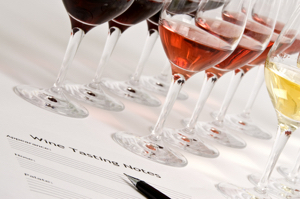It’s easy to find yourself lost, confused or intimidated by all of the lingo in the wine world. Tasting notes can sometimes feel impossible to decipher, and use descriptions that make it difficult to really understand the wine, like this one: “Well seasoned oak supports the floral scent of musky black roses and a savory thorny understory like a briar growing through straw mulch after a recent rain” (yes, that is an actual tasting note).
Let’s start to deconstruct and untangle some of the most common wine lingo, so the next time you hear these descriptors you will know exactly what they mean.
1. Acidity
It’s the acidity in wine that causes a sharp sensation in your mouth and triggers your salivation reflex. The more you salivate and the longer you salivate, the higher the acidity level in the wine. Wines that have low acidity are often described as “round” and “soft”, while wines that have high acidity are sometimes described as “vibrant” and “fresh”. You will often find higher acidity in wines from cooler regions.
- Examples of high acidity wines: Sauvignon Blanc, Riesling, Chenin Blanc, Champagne, Pinot Noir
- Examples of low acidity wines: Chardonnay, Viognier, Grenache, Merlot, Gewurtztraminer
2. Balance
In every wine a battle is waged between fruit and sugar on one side, and acidity and tannins on the other side. Balance between these sides is achieved when all of these elements are well integrated so none stands out too much over the other. Too much fruit and sugar can make a wine taste cloying, while too little makes a wine taste austere and thin. Too much acidity and tannins can make a wine harsh or aggressive, while too little makes it unstructured and flabby.
3. Body
Body is the mouthfeel of a wine, or the weight of it on your tongue. Sugar, tannins and alcohol contribute to a fuller bodied wine, while acidity makes a wine feel lighter. Many wine professionals use the following comparison to determine the body of a wine: light body = skim milk, medium body = 2% milk, full body = whole milk.
- Examples of full-bodied wines: Cabernet Sauvignon, Syrah/Shiraz, Malbec, California Chardonnay
- Examples of light-bodied wines: Pinot Noir, Beaujolais, Grenache, Barolo, Prosecco, Riesling, Rosé
4. Complexity
Complexity refers to the number of different flavors and aromas that can be identified in a wine. A wine that only shows a few similar fruit flavors (e.g., lemon, lime, green apple) would be considered simple. A wine that shows a multitude of different characteristics across a variety of flavor/aromas categories (e.g., red cherry, blackberry, raspberry, pepper, toast, mushroom, vanilla) would be considered complex.
5. Dry
Dry wines are those that have no residual sugar left in them after fermentation. During fermentation, yeasts consume sugars in the grapes and convert them into alcohol. In a dry wine, all of the grapes sugars are fully converted into alcohol. A dry wine can still be fruity (see #7) if it contains flavors and aromas of fruits, but there is no actual sugar in the wine.
6. Finish
Finish, also referred to as length, measures how long the pleasant flavors remain on your tongue after you take a swallow of wine. Typically, a higher quality, more intense wine will have a longer finish.
7. Fruit-Forward
Fruit-forward, or fruity, is not used to described the sweetness or sugar content in a wine. A wine can be dry and still fruit-forward. This term is used to describe wines that are packed with primary fruit flavors (e.g., apple, peach, pear, lemon, lime, grapefruit, etc.) that stand out as the defining characteristic of the wine.
- Examples of fruit-forward wines: Sauvignon Blanc, Chenin Blanc, Pinot Gris/Grigio, Vinho Verde, Zinfandel, Grenache, Shiraz
- Examples of non-fruity wines (earthy, herbaceous): Many French wines, such as those from Bandol (Mourvedre) and Cahors (Malbec)
8. Oaky
An oaky wine is one that has picked up flavors and aromas from being fermented and/or aged in oak barrels. Oak will impart different flavors and aromas based on the type of wood, the barrel size, degree of charring on the inside of the barrels, and time spent in barrel. Characteristics imparted by oak include toast, cedar, smoke, vanilla, coconut and sweet baking spices (cinnamon, nutmeg, etc.).
9. Tannins
Tannins are found on grape skins, so grapes that have spent more time macerating (or soaking in) a vat with their skins will produce more tannic wines. Tannins cause your mouth to dry up. The easiest place to notice this is the gums above your front teeth. Tannins can also leave a slightly bitter taste at the back of the mouth. Tannins are important to the structure of a wine, giving wines texture and body.
- Examples of high tannin wines: Cabernet Sauvignon, Syrah, Barolo
- Examples of low tannin wines: Pinot Noir, Beaujolais, Tempranillo
10. Terroir
Terroir is a French word that is used to describe a wine’s “sense of place”. It encompasses the idea that wine should be an expression of the environmental factors where the grapes are grown and the wine is produced, inclusive of the soil, climate, farming, elevation, slopes, direction of sunlight, etc. In France, every vineyard is seen as having its own unique terroir. The value the French put on terroir is why French wines are labeled by region or chateau rather than grape variety.
Are there other wine terms that you would like to better understand? If so, comment on this post or contact me to have your term added to the next list!





